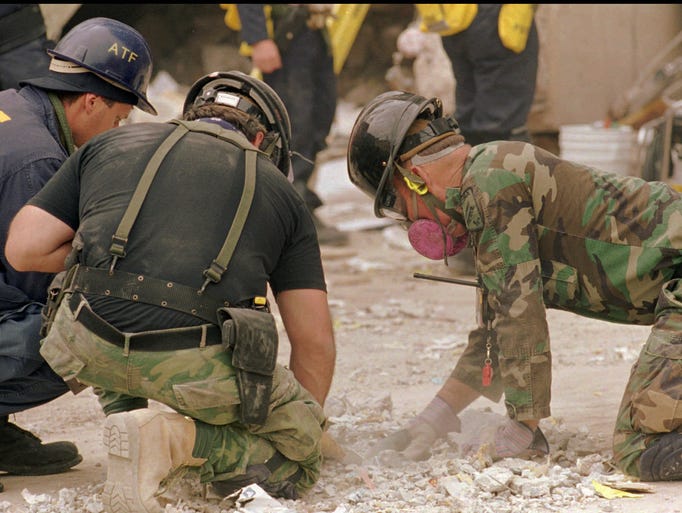April 19, 1995, marks a dark chapter in American history as the day when the Oklahoma City bombing took place. This devastating act of domestic terrorism claimed the lives of 168 individuals, including 19 children, and left over 600 injured. The bombing was not only a tragedy but also a pivotal moment that reshaped America’s perception of domestic terrorism, security, and community resilience. This article aims to explore the events of that fateful day, the aftermath, and the lessons learned, ensuring that we remember and honor the victims and heroes of this tragic incident.
The Lead-Up to the Bombing

The Oklahoma City bombing was carried out by Timothy McVeigh, a Gulf War veteran who was motivated by his opposition to the federal government, particularly in response to events like the Waco siege in 1993. McVeigh, fueled by a sense of anger and revenge, meticulously planned the attack with the intent to make a political statement against what he perceived as government overreach.
- Waco Siege (1993): The standoff between federal agents and the Branch Davidians ended tragically, influencing McVeigh’s views on government actions.
- Militia Movement: McVeigh was influenced by extremist groups advocating for a return to what they deemed as constitutional government.
- Preparation: In the months leading up to the bombing, McVeigh and his accomplice, Terry Nichols, gathered materials to build a massive explosive device using ammonium nitrate.
The Day of the Bombing

On the morning of April 19, 1995, McVeigh parked a Ryder truck filled with explosives outside the Alfred P. Murrah Federal Building in downtown Oklahoma City. At 9:02 AM, he detonated the bomb, resulting in a massive explosion that obliterated the front of the building and caused extensive damage to surrounding structures.
- Immediate Impact: The explosion killed 168 people, including 19 children in the building’s daycare center.
- Injuries: Over 600 individuals were injured, many suffering from severe trauma and life-altering injuries.
- Destruction: The blast destroyed the Murrah Building and damaged over 300 nearby buildings, leading to a significant economic impact on the community.
Aftermath and Response

The immediate aftermath of the bombing saw a massive rescue and recovery operation. First responders, including firefighters, police, and emergency medical personnel, worked tirelessly to search for survivors and recover bodies. The community came together in a remarkable display of solidarity and resilience.
Community and National Response
The horror of the bombing resonated far beyond Oklahoma City, prompting national outrage and sorrow. Vigils were held across the country, and the event became a rallying point for discussions about domestic terrorism and national security.
- Vigils and Memorials: Communities organized memorial services to honor the victims, including a national moment of silence.
- The Oklahoma City National Memorial: Established to honor the victims and survivors, the memorial serves as a powerful reminder of the impact of violence.
- Legislative Changes: The bombing prompted discussions about anti-terrorism legislation, leading to the passage of laws aimed at preventing similar attacks.
Legal Proceedings and Justice

Timothy McVeigh was arrested shortly after the bombing and was tried and convicted for his role in the attack. He was sentenced to death and executed on June 11, 2001. Terry Nichols, his accomplice, received a life sentence without parole. The legal proceedings highlighted the complexity of domestic terrorism and the challenges of addressing such heinous acts in a legal framework.
Key Legal Outcomes
- McVeigh’s Trial: The trial drew national attention, with extensive media coverage and public interest.
- Nichols’ Sentencing: Nichols was tried in both state and federal courts, ultimately receiving life imprisonment without parole.
- Impact on Legal System: The bombing raised questions about the adequacy of existing laws to handle domestic terrorism, prompting legal reforms.
Long-Term Effects on Society
The Oklahoma City bombing had profound and lasting effects on American society. It reshaped the national dialogue on terrorism, security, and the balance between civil liberties and safety.
Changes in Security Protocols
- Increased Security Measures: Government buildings and public spaces implemented stricter security protocols to prevent similar attacks.
- Public Awareness: The event raised awareness about the threat of domestic terrorism and the importance of community vigilance.
- Emergency Preparedness: Local and federal agencies improved emergency response plans and training for potential terrorist attacks.
The Importance of Remembering
Remembering the Oklahoma City bombing is vital not only to honor the victims and their families but also to learn from the past. It serves as a reminder of the consequences of hatred and violence and the need for vigilance against extremism in all its forms.
Commemorative Efforts
- Annual Remembrance Ceremonies: Each year, survivors and families gather to remember the victims and reflect on the impact of the bombing.
- Educational Initiatives: The Oklahoma City National Memorial and Museum offers educational programs to teach future generations about the importance of tolerance and understanding.
- Community Engagement: Local efforts continue to promote healing, unity, and resilience in the face of adversity.
The Oklahoma City bombing remains a stark reminder of the fragility of peace and the devastating consequences of violence. It is a day etched in the collective memory of a nation, serving as both a cautionary tale and a call to action against hatred and extremism. As we remember the lives lost and the heroes who emerged from the tragedy, it is imperative that we strive for a more compassionate and understanding society. By honoring the past, we can work towards a future defined by unity, resilience, and hope.


